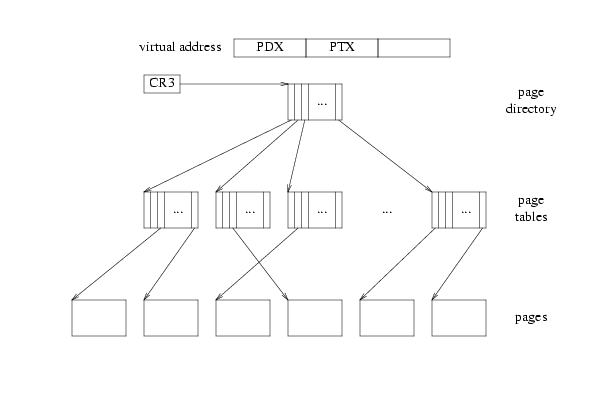The UVPT
Overview
A nice conceptual model of the page table is a 220-entry array
that is indexable by a physical page number. The x86 2-level paging
scheme breaks this simple model by fragmenting the giant page table
into many page tables and one page directory. In the kernel we used
pgdir_walk() to lookup entries by walking down the two-level page
table. It would be nice to get the giant simple page-table back in
some way—processes in JOS are going to look at it to figure out
what’s going on in their address space. But how?
This page describes a neat trick that JOS uses by exploiting the paging hardware—the paging hardware is great for putting together a set of fragmented pages into a contiguous address space. And it turns out we already have a table with pointers to all of our fragmented page tables: it’s the page directory!
So, we can use the page directory as a page table to map our conceptual giant 222-byte page table (represented by 1024 pages) at some contiguous 222-byte range in the virtual address space. And we can ensure user processes can’t modify their page tables by marking the PDE entry as read-only.
Puzzle: do we need to create a separate UVPD mapping too?
Detailed explanation
Remember how the x86 translates virtual addresses into physical ones:

CR3 points at the page directory. The PDX part of the address indexes into the page directory to give you a page table. The PTX part indexes into the page table to give you a page, and then you add the low bits in.
But the processor has no concept of page directories, page tables,
and pages being anything other than plain memory. So there’s nothing
that says a particular page in memory can’t serve as two or three
of these at once. The processor just follows pointers:
pd = lcr3();
pt = *(pd+4*PDX);
page = *(pt+4*PTX);
Diagramatically, it starts at CR3, follows three arrows, and then stops.
If we put a pointer into the page directory that points back to itself at index V, as in:

then when we try to translate a virtual address with PDX and PTX
equal to V, following three arrows leaves us at the page directory.
So that virtual page translates to the page holding the page
directory. In JOS, V is 0x3BD, so the virtual address of the UVPD
is (0x3BD<<22)|(0x3BD<<12).
Now, if we try to translate a virtual address with PDX = V but an
arbitrary PTX != V, then following three arrows from CR3 ends one
level up from usual (instead of two as in the last case), which is
to say in the page tables. So the set of virtual pages with PDX = V
form a 4MB region whose page contents, as far as the processor is
concerned, are the page tables themselves. In JOS, V is 0x3BD so
the virtual address of the UVPT is 0x3BD<<22.
So because of the “no-op” arrow we’ve cleverly inserted into the page directory, we’ve mapped the pages being used as the page directory and page table (which are normally virtually invisible) into the virtual address space.